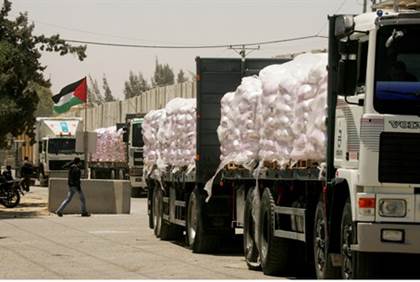UPDATES
Israel continues to deliver humanitarian aid to Gaza, despite Hamas’ efforts
August 12, 2014 | Gabrielle Debinski

In recent weeks, the media has focused overwhelmingly on the ‘humanitarian crisis’ developing in Gaza. Interestingly, neither the media nor the UN or other ‘human rights’ groups – quick to condemn Israel for imposing a partial ‘blockade’ on the Gaza Strip – have made any mention of the thousands of trucks of humanitarian aid that have continued to pour in from Israel. They continued coming even in the face of incessant Hamas rocket fire hitting Israeli towns and cities, and they continued coming even as Hamas attacked the border crossing itself.
The Kerem Shalom crossing, the only transit point for delivering supplies from Israel into Gaza, has remained open since Operation Protective Edge began on July 8, in spite of rocket and mortar fire which has sometimes landed dangerously close to the crossing itself.
With the Israeli blockade preventing sea-based imports, outside Kerem Shalom, there are only two other entry points in and out of Gaza. The Rafah crossing along the border with Egypt has been closed since July 2013, allowing only for minimal pedestrian entry, while the Erez crossing into Israel is also used only for pedestrian travel. Accordingly, the Kerem Shalom transit point is the commercial lifeline for Gaza and the only access point for Gazan civilians to receive essential aid supplies.
According to Israel’s Ministry of Foreign Affairs (MFA), in the month between July 8 and August 8, 2772 trucks have entered the Gaza Strip via the Kerem Shalom crossing bringing in food, medical supplies, medical equipment, gas and fuel.
Data released by the MFA reveals that during that time, Israel delivered 4.44 million litres of diesel for the power station in the Gaza Strip, 1.04 million litres for UNRWA, 4.93 million litres of other fuel, 2.22 million liters of gasoline for transportation and 2,676 tons of gas for domestic needs.
According to data released by MFA 1,491 trucks with 37,178 tons of foods, 220 trucks with 1,694 humanitarian supplies and 106 trucks with 1,029 tons of medical supplies were delivered to Gaza between July 8 and August 5.
Further, while the media has focused on the humanitarian situation in Gaza, arbitrarily linking it to Israel’s partial blockade of the Strip – which allows in as much food, medicine, or consumer goods as the Palestinians wish to import – rather than Egypt’s full humanitarian blockade, what has gone under the radar is the key role Hamas continues to play in engineering this crisis. Hamas’ actions have actively prevented Israel from delivering supplies to the residents of Gaza.
Further, on August 8, despite Hamas’ resumption of rocket fire after a 72-hour humanitarian ceasefire had expired, 135 trucks carrying humanitarian aid entered the Gaza Strip through the Kerem Shalom crossing.
As mentioned before, since July last year, the Kerem Shalom transit point has been Gaza’s only lifeline for receiving essential medical and food supplies. Yet Hamas has bombarded Kerem Shalom with rocket and mortar fire, sent its own militants to the crossing to blow themselves up, disrupting the delivery of key food supplies as trucks lining the border were made to turn around, and it launched three separate tunnel attacks near the Kerem Shalom border, resulting in the crossing being sealed for hours on end.
A case in point occurred on August 1, when Hamas violated the UN/US humanitarian cease-fire, intended to allow humanitarian aid to reach the residents of Gaza, by firing a barrage of rockets at the Kerem Shalom crossing and thwarting the entry of 91 trucks carrying food, water, gas, medicine and other essential equipment.
Remarkably, despite this, Israelis continue to risk their lives to keep the crossing open and the flow of goods coming into the Gaza Strip. It seems likely this flow would have been even higher had Hamas attacks not subverted Israel’s efforts to deliver more supplies.
In the Jerusalem Post, Ami Sheked, the ‘crossing head’ who oversees the delivery of goods from Israel into the Gaza Strip, explained how difficult keeping the aid flowing has been.
Accompanying a group of journalists on a ‘tour’ of the crossing Shaked explained the precariousness of his job:
“Even at this moment, a mortar could fall and people would be wounded while undertaking a humanitarian mission for the people of Gaza.”
“It’s not a normal situation.”
When asked whether the suicide bombings that killed three Israeli soldiers a short distance from the Kerem Shalom border demotivate him or whether incessant rocket fire made him lose sight of his mission, Shaked’s view was unwavering:
“This place was like hell. It was under fire. There were a lot of explosions and mortars and a lot of shooting.”
“My target is to move humanitarian aid to the Palestinian side. This is what I do. It doesn’t matter if it’s under fire or not under fire.”
He also made it clear what the rules of the blockade actually are – and they are very different from what many commentators seems to think. He said “the amount of commercial and humanitarian supplies that enter the Gaza Strip…is determined by the Palestinians.”
“They set the level of demand and Israel meets it.”
Moreover, underlying much of the media discussion on the humanitarian crisis in Gaza has been claims of a shortage of medical care, whereby Gaza’s hospitals have been unable to cope with the huge flood of casualities and have nowhere to send the influx of injured Palestinians.
Yet, not only has Israel allowed around 400 Palestinians to enter Israel in local ambulances seeking medical treatment in hospitals in Israel and the West Bank, but it also set up a field hospital on the Gaza border to treat wounded Palestinian civilians.
The field hospital, however, has remained mostly empty during the conflict. According to Israel this is a perverse outcome of Hamas instructing Palestinian civilians not to seek care in the Israeli-run facility.
Since its establishment on July 21, the hospital has helped only around 50 injured Palestinians.
Sharon Biton, the Coordinator of Government Activities in the Territories, which set up the hospital together with the Medical Corps, reiterates that the field hospital has nothing to do with the “fighting going on inside” and blames Hamas for preventing Palestinians from seeking their care.
Meanwhile, there is also a report that Israel prepared medical supplies worth millions of dollars including medicine, chemotherapy and medical equipment, to be sent to Gaza, but this was refused by the Palestinian Authority. Israel also promised to treat any Gazans needing help in Israeli hospitals.
Then there’s the issue of reported electricity shortages in the Gaza Strip. Yet, not only have Hamas rockets hit electricity lines carrying power from Israel to Gaza twice in the last month, but also, their incessant rocket fire prevented access to the sites to repair the power lines.
At the same time, Israel has been criticised for reportedly bombing a power station in Gaza, which is the only power plant in the Strip, on July 29. While the circumstances are unclear, it appears to have been an accident.
Yet in an online article published in the Washington Post, Professor Eugene Kontorovich of Northwestern University School of Law argues that even if Israel had targeted the plant, this would be perfectly legal under the laws of war.
He states that in fact “civilian power stations are legitimate military targets in an armed conflict, and have been heavily targeted by Western countries in most recent conflicts. Thus even if Israel deliberately targeted the Gaza power plant, this would be well within international practice.”
He even notes that “The military manuals of many Western countries, like the UK and Australia, specifically list electric facilities as legitimate military targets.”
Yet he notes something further – Israel has continued to supply power to Gaza, from its own power plants, throughout the conflict, and this is not only not required in war, but virtually unheard of. Further, they are doing so even though no-one is paying for the power. He notes:
“…we’ve been talking about destroying enemy power installations. This is permitted. A fortiori, simply not giving the enemy from one’s own power stations would not even be a question. But Israel’s action would be even one step away from that. The Palestinians have not been paying for the power they are consuming. Their electrical bill is due. Bombing enemy power plants is ok; not selling them power is a fortiori ok; and thus not letting them take it for free is, for lack of a better term, a double a fortiori.” [“a fortieri” is a legal term that means that if one thing is true then it can be inferred that a second thing is even more certainly true. ]
Meanwhile, on August 6, Israel reportedly transferred 10 generators to Gaza to ensure hospitals would have adequate power.
From the above, there is one consistent theme that emerges; Israel has been doing everything it reasonably can to ensure the humanitarian situation in Gaza does not deteriorate more than is inevitable from having a war fought there. Moreover, Israel’s considerable efforts to try to ensure Gazans receive food, medicine and other essentials make it absolutely clear that the wild claims being made about how Israel is deliberately “targeting” Gaza’s civilian population, or seeking to “collectively punish” them are completely divorced from reality.
Meanwhile, Hamas is actively sabotaging Israeli efforts to carry humanitarian aid to its own people and sitting back as it watches Israel take the blame for a ‘humanitarian crisis.’
Gabrielle Debinski
Tags: Israel





